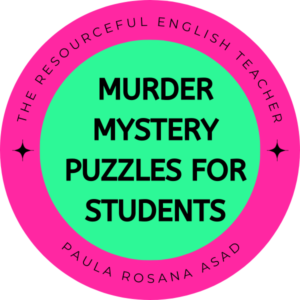Whodunnit? Murder Mystery Puzzles for Students!
Are you looking for a fun and creative way to help English language learners hone their critical thinking skills? Whodunnit activities are the perfect way to combine education and entertainment. Engage your students in an interesting and engaging murder mystery adventure where they must use their deductive skills to solve a case. By using mystery scenarios and stories, you can make the language learning experience more enjoyable and promote active learning. In this article, we’ll discuss how to create and use murder mystery scenarios to help English language learners explore problem-solving and critical thinking concepts in a fun interactive way. So, whether you’re looking for a spooky activity this Halloween or a creative way to promote critical thinking, murder mystery puzzles can help your students develop their language skills while having a great time!

You can use the murder mystery puzzles in different ways.
1)Costume Parade and Investigation:
Divide students into small groups, read each group a murder mystery scenario, and assign different characters. Organize a costume parade where students dress up as their assigned characters. As they parade, they share clues or alibis with the rest of the class who are going to have the role of detectives. The student who guesses who the murderer is becomes the winner.
2) Critical Thinking and Problem Solving:
Present a murder mystery scenario and have students work in teams to solve it by analyzing clues and evidence. Ask students to develop their theories about the crime and explain their reasoning, fostering critical thinking skills.
3) Creative Writing:
Have students write their own murder mystery stories, complete with characters, clues, and a solution. Encourage creativity by allowing them to set their mysteries in different time periods or locations.
4) Role-Playing and Acting:
Assign students different characters involved in the murder and have them act out the roles. This can help improve their speaking and listening skills while engaging them in dramatic play.
5) Cross-Curricular Integration:
Use murder mystery scenarios to teach concepts from other subjects. For example, incorporate math by having students analyze timelines or calculate alibis. Integrate history by setting the mysteries in specific historical periods.
6) Project-Based Learning:
Organize a project where students must create a multimedia presentation or documentary based on a murder mystery scenario. This can incorporate research, writing, and presentation skills. Learn how to work with projects HERE!
Murder mystery puzzles are a great way to have fun while developing language skills in an interactive and engaging way. They can help create memorable learning experiences for English language learners and promote problem-solving and critical thinking. Through different activities murder mystery puzzles can turn language learning into an exciting adventure. So, why not give it a try this Halloween and create an unforgettable language-learning experience for your students? Download a FREE copy of my “Murder Mystery Puzzles” and use it this Halloween CLICK HERE!

